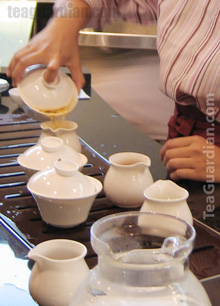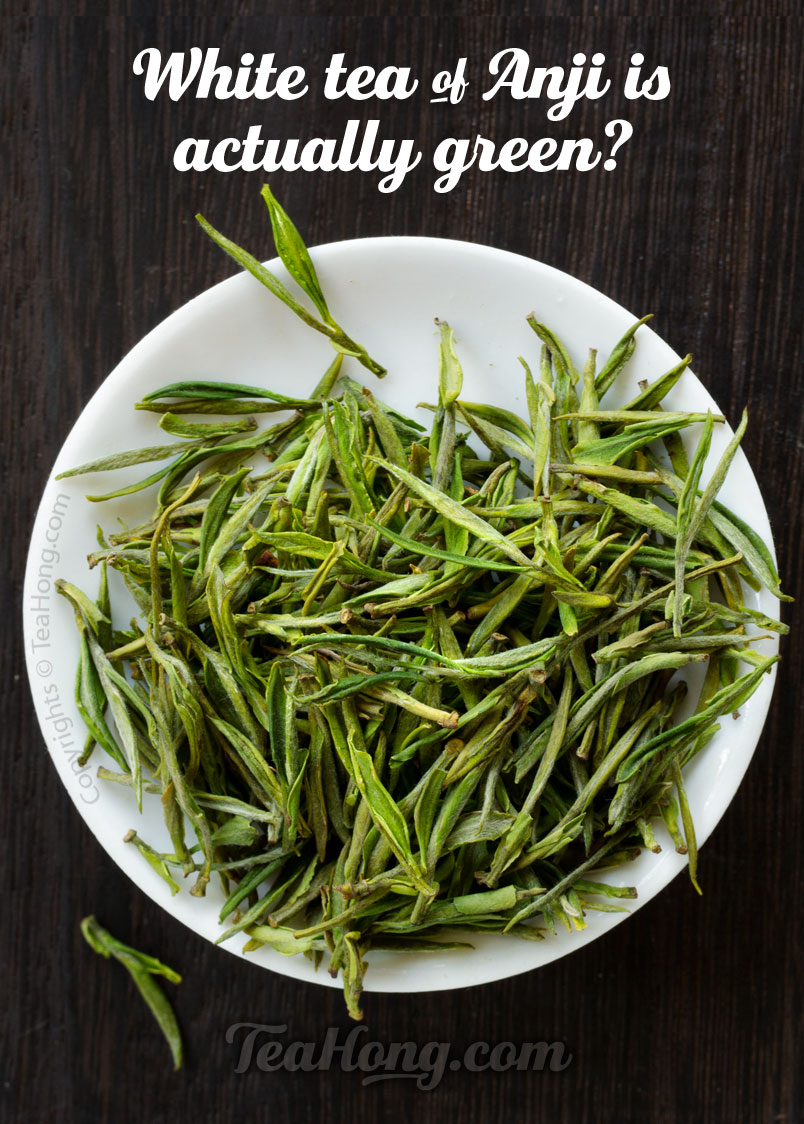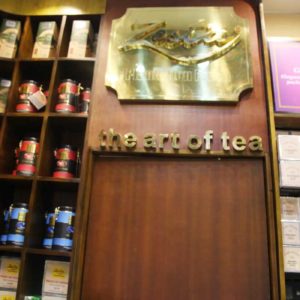Phoenix Oolong: Classic Styles
- This particular batch of Milan Xiang is from Wudong, the mecca of Fenghuang Dancong. The duller surface is a result of the additional twisting done particularly to most longer baked classic styles, where the tea juice dries out to leave crystallized tea substances on the exterior, a great portion is caffeine. Notice the distinctive more baked colour of the leaves. Better executed bake is never over, reviewing the lighter colour yellow leaf ends. Milan Xiang, whether ganged with other bushes of the same cultivar and quality, or really from a single bush, has a temptatious fruity sweetness resembling either the peach, lychee, or sweet yam, depending on the horticulture and processing.
- Milan Xiang Dancong, medium high quality.
- This is a more popularly accessible quality of the Milan Xiang variety.
- Rebaked Baxian, aka Eight Immortal Rebaked, 復焙八仙, is produced by rebaking a floral style Phoenix dancong 20238 | 8668
- This is an acceptable quality batch. Notice the close resemblance with Milan Xiang, and the typical longer bake, except for the looser twist and coarser leaves. This is nevertheless a first flush. Guihua translates as osmanthus flowers, relating to the natural fragrance of this variety. A favourite in the domestic market and finer ones are rare outside of the Chaozhou area, even at a price. Producers have resort to scenting various quality grades with osmanthus flowers to imitate the natural, making the label more accessible. We’ll review this scented tea later.
- Osmanthus Milan Xiang 蜜蘭桂花香, scented with fresh flowers of osmanthus
Fenghuang Dancong ( fèng•huáng dān•cōng ) Chinese: 鳳凰單欉, aka Phoenix oolongs. There are two distinct groups within this sub-category of oolongs. In this article, we shall look at the classic style group, also called the ripened style ( Chinese: 熟香型 ), or the traditional style. (Click here if you want to look at the other group) As mentioned in the category orientation, this grouping is much abridged for easy understanding. Other articles will cover details of specific selections and specialisation grouping.
sweet ripen fruits and honey
A classic style Phoenix oolong is characterized with a pleasant aroma of sweet ripen fruits such as peach or baked sweet potato, accented with honey and a deep, woody yet floral undertone. No other teas can be similar to it.
Matured under the right condition, the aroma acquires a woodsy depth with characteristic accents that can be associated with dried fruits such as longan and lychee.
The liquor is a long bitter-sweet with tinkling of tints of citrus peels and accents of other flavours, such as roasted cocoa, ginger flower, almond or honey, etc, or a combination of some, depending on the variety.
Each variety or even selection has its own distinctive taste profile under the broad wash description.
This is my personal staple drink. I have yet to find another tea with the kind of taste complexity and aromatic comfort that can both sooth and tickle my senses when I have it every day since 1999.

New leaves shooting up from the tea bushes. This one from the cultivar Baiye, in Wudong, Fenghuang (Phoenix). Notice the dramatically lighter colour of the new leaves. This is the reason for the cultivar’s name, which means “white leaves”. “White” is a general adjective still used today in rural China for light colour.
tree cultivars
The ultimate cultivar used in the classic style is Huangzhi Xiang ( Chinese: 黃枝香 or 黃橘香 ), but the demand for it is so high that the price for most top quality batches has gone quite unreachable in the past 10 years. Producers have also generally lightened the oxidation and the baking to turn this into a borderline between the classic style and the bouquet style in order to acquire a more floral aroma in the dry leaves for better appeal. And for higher prices.
A more accessible variety is Milan Xiang ( Chinese: 蜜蘭香 ). Selections popularly available are generally produced from a group of cultivars called Baiye ( baí•yè, i.e. white leaf. Chinese: 白葉 ). A cultivar named Milan Xiang does exist. The oldest specimen is known to have lived since the Qing Dynasty. It and all its relatives and “off-springs” are producing, except that the product easily got unfairly compared in price with the production from Baiye. Its complex and wonderful taste profile is thus lesser known.
Other popular production cultivars include Guihua Xiang ( Chinese: 桂花香 aka Qun’ti Dancong 群體單欉 ), Xinren Xiang ( Chinese: 杏仁香 ), and Jiangmu Xiang ( Chinese: 薑母香 ). In finer oolong production where the nature of the leaves is essential to the taste character of the product, development of cultivars is active and blooming in a competitive and yet lucrative market such as China. New ones, and thereby, new tea varieties come about regularly. <read more about production>
selection tips
The classic style is different from the bouquet style with deeper oxidation and baking.
Baking is a decisive factor in the quality. Over-baking, mostly through higher than needed temperature, causes an undesirable burnt taste. A fresh production is often baked not so deep, allowing a livelier freshness. An older stock is often rebaked for maturing. A rebaked tea should be consumed no less than 3 months after the rebake. It can be stored for peak quality between year 2 and 5 or longer, very much dependent on the original quality and the baking done onto it.
Always select a spring or first flush harvest for all classic varieties. That is true for fresh consumption or for maturing.
Productions from all cultivars specialised in the bouquet style can also be browned to make into the classic style, if when the oxidation and initial drying are properly done. As mentioned, Huangzhi Xiang, the ultimate Phoenix, is a good example. However, this is a very tricky process and few producers can really master it.
It is advisable, therefore, to buy typical and properly processed classic style and not those re-finished ones.
tasting note
Classic style Phoenix is perhaps the most delicate tea to infuse in the gongfu approach. You’d rather use a lower than higher temperature or it can taste too sharp or too bitter. Using the conventional approach particularly with the top drop method, however, is almost always successful for beginners.
Use less leaves when you are beginning to learn about the tea.
I always love a fine single batch fresh classic Phoenix oolong, when it is a few months old. For the leftover stock ( usually I have enough for a lot of leftover ), I will let it mature for 2 to 3 years, when it turns intensely sweet and rounder. Every time a cup of finely prepared Milan Xiang Dancong makes me puzzle what good have I done to deserve such wonderful luxury.
A classic Phoenix oolong is a powerful digestive so it’s good when you want to be prepared for a great meal, or if you have had one. They are not so suitable when you are going on diet. This is a great tea to be enjoyed pure, or coupled with desserts, pastry or seafood.

Harvesting from an old tea tree in Fenghuang (Phoenix). Notice while the product from the old tree may demand a very high price, that from the “off-springs” in the slope immediately nearby maybe more affordable. The taste can be very close.
buying tips
The cost for this tea can vary extremely dramatically. The mecca of Phoenix production is Wudong ( Chinese: 烏崠 ) where end-users who are nova riches or the powerful send their subordinates here every late April or early May to get those harvests from reputable Single Bushes of hundreds of years of age. This brings up the price ridiculously. A catty (500 g) of pre-finished tea (maocha) can fetch a few hundred thousand RMB (check exchange rate). The demand is so high that some local farmers would buy plucks from outside of Wudong to process there in the place of real local leaves. There are a few more tricks that some producers and farmers perform to the ends of imitating genuine Wudong production for higher prices.
The fact is, although finer genuine Wudong productions are really supreme, some other su-regions in Phoenix ( Fenghuang ) can be wonderful too. Even though their prices have gone up a couple of times since the last decade, they are still within reasonable limits, for their quality.
A fine classic style from high altitude, whether from Wudong, or the neighbouring Ermao or Shitou, has a distinct and slightly different “yan’yun” ( Chinese: 岩韻 i.e. note of the large rock, translate: character of high altitude grown; a special and complex note of certain herbal/mineral character that is difficult to imitate because it harmonizes with the rest of the taste and aroma character ).
I buy directly from the producers or farmers whether for personal use or for trading. When you shop for one at the dealers or retailers, you should give much less weight to claims of origin and pay emphasis on the taste. The fact is, every so often I find products not matching the claim ( and the price ) even at wholesalers. Whether they know what they are doing is a mystery, but I hate it when the end users are not getting what they pay for.
health note
This is a great tea to keep staying calm and awake especially for those who cannot use green tea which is TCM cold, or black tea which causes dampness (TCM term). Classic style Phoenix is relatively neutral, and therefore a great daily tea for most. <read: Health aspect of Phoenix oolongs>
In some science reports, Fenghuang Dancong outranked top quality Longjing for total tea polyphenol and catechins content. This will be discussed in other articles. However, this does implies that for long term use for people with more sensitive stomach, this is an ideal option as a healthy beverage.
However, it can be a strong tea to some people so if you have not had much strong tea experience, increase your intake strength and quantity gradually and do not drink on an empty stomach. If you forget about this and over drink, you may experience tea-drunk. Have a bite of something to raise blood sugar and refrain from drinking that day. <read more about tea drunk>
If your tea experience is only beginning, a safe way to start experiencing this tea is to have one cup at just adequate strength for a half day, with a cookie or any little bites standing by.
On the other hand, if you are a veteran, this really is a worthwhile tea to spend time and efforts to explore and understand. Once you find a really fine selection, maybe you would begin to experience the kind of health change I had and keep it as one of your daily drinks.


















1 Response
[…] Dancongs are also effective digestive. This tea may be strong to certain people. Drink in small sips while the tea is still comfortably hot. Don’t drink this tea cold. <Read more about dancongs> […]